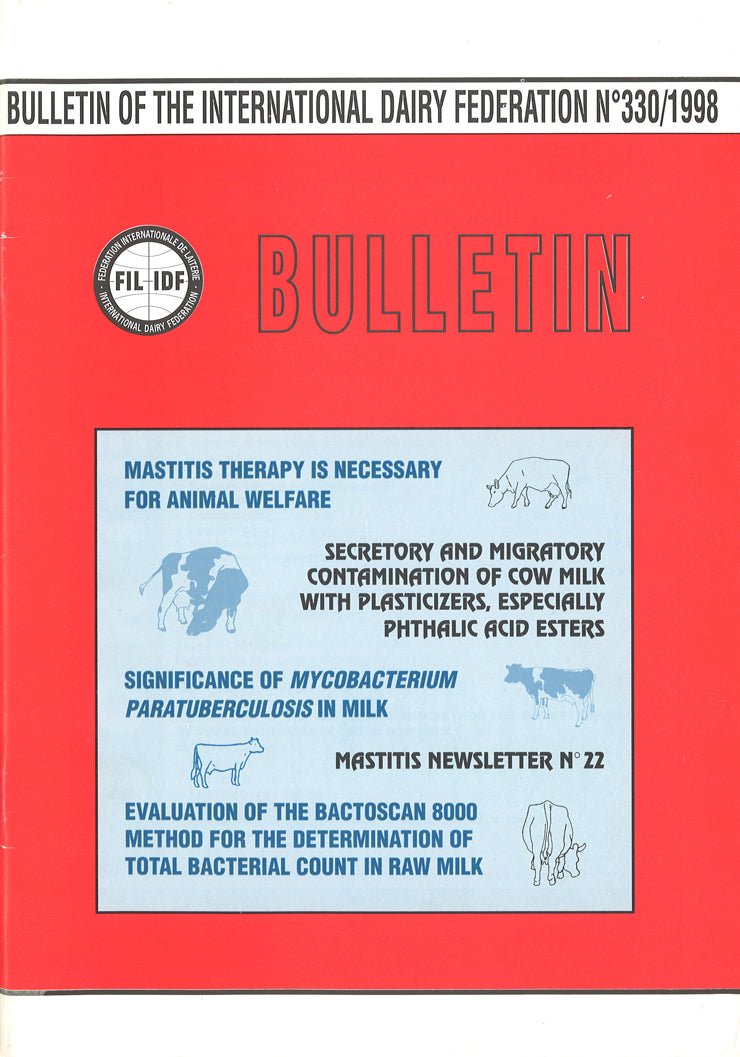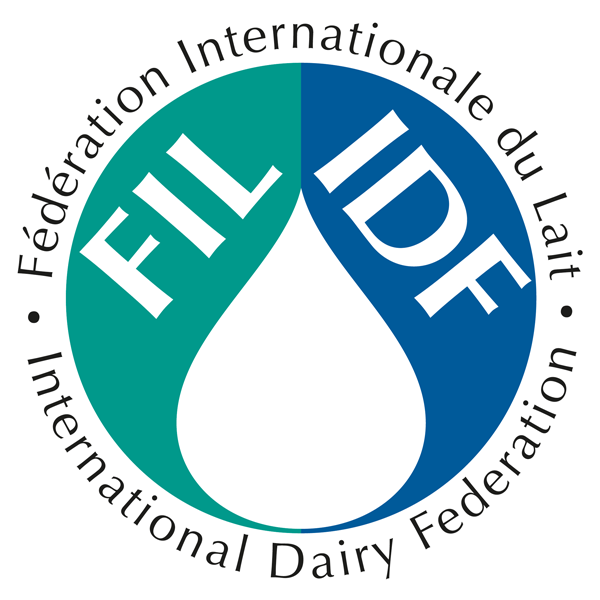Bulletin of the IDF N° 330/1998 - Mastitis Therapy Is Necessary for Animal Welfare
Couldn't load pickup availability
Document info
| pages | 52 |
|---|---|
| published date | 24 March 1998 |
| reference | Bulletin of the IDF No. 330/1998 |
Publication description
Mastitis Therapy Is Necessary for Animal Welfare
Presentation by J.E. Hillerton (UK) for Group A2 at the 1997 Annual Sessions held in Reykjavik (Iceland)
Mastitis is a painful condition causing moderate to severe distress. The dairy industry has the dual concern of the wellbeing of its cows and the image of its products. The dairy cow has the right to be free of discomfort, pain, disease and distress. The treatment of mastitis has to be viewed within a broad political dimension composed of animal welfare, antibiotic resistance, residues, control of products, and epidemiology of the problem.
2 pp
Secretory and Migratory Contamination of Cow Milk with Plasticizers, Especially Phthalic Acid Esters
Presentation by A. Blüthgen & W.H. Heeschen (Germany) for Group A4 at the 1997 Annual Sessions held in Reykjavik (Iceland)
The use of plasticizers in the environment of the dairy cow and milk is discussed. The results of a feeding assay to confirm the extension of the secretory route of contamination after oral supplementation are presented.
6 pp
Significance of Mycobacterium paratuberculosis in Milk
Presentation by P. Hammer, K. Knappstein & G. Hahn (Germany) for Group A30 at the 1997 Annual Sessions held in Reykjavik (Iceland)
In this review, data on the biological properties, habitat and economical impact of Mycobacterium (M.) paratuberculosis are presented. Its significance for Johne’s disease of dairy cattle and for Crohn’s disease of humans is explained and a possible linkage of both diseases is discussed. Data concerning the heat resistance of M. paratuberculosis in milk are reviewed, including trials in laboratory and commercial systems. A preliminary risk assessment according to Codex Alimentarius procedures is performed based upon the available information.
5 pp
Mastitis Newsletter N°22
General
Report of the IDF Group of Experts on Mastitis – K. L. Smith, Chairman (USA)
Erratum Mastitis Newsletter No. 21.
Research Communications
Differential Somatic Cell Counts in Milk – A. Saran, G. Leitner & M. Chaffer (Israel)
Effect of Undermilking and Overmilking on Teat Tissue Condition – E. O’Callaghan (Ireland), D. Gleeson (Ireland) & F. Neijenhuis (the Netherlands)
Effect of Various Milking Machine Systems on Free Fatty Acid Development in Milk – B. O’Brien, E. O’Callaghan & P. Dillon (Ireland)
The Use of Lacticin 3147 in Mastitis Control – M. Ryan, W.J. Meaney, C. Hill & P. Ross (Ireland)
Decision-Making in Clinical Mastitis Therapy Programmes – K. Leslie & G. Keefe (Canada)
Vaccination against Coliform Mastitis: A Historical Perspective – K.L. Smith & J. Hogan (USA)
Mastitis notes from member countries
Italy: Staph. aureus: A Problem for Italian Dairy Herds – A. Zecconi & R. Piccinini
New Zealand: Daily Somatic Cell Count Testing – R. Franks
Spain: Milk Quality in Spain – E. Cifrian, J.A. Garcia, P. y. Casado & J.C. Marco
Switzerland: Evolution of Somatic Cell Counts in Bulk Milk Samples: Switzerland 1983–1996 – M. Schällibaum
Events & Meetings
Report of the Seminar “A half Centenary of Lactation Biology Research”, University of Gent, Belgium, 20–22 November 1996 (D. Hoeben) The Future Use of Antibiotics in Mastitis Therapy: A Report from a Nordic Seminar in January 1997 (Ch. Hallén Sandgren) US National Mastitis Council Annual Meeting – 1997 (K.L. Smith & A. Saeman)
Subclinical Bovine Mastitis – Prevention and Therapy. Conference of the German Veterinary Association, Grub/Munich, 27–28 September 1996 (J. Hamann)
IDF Publications on Mastitis
20 pp
Evaluation of the Bactoscan 8000 Method for the Determination of Total Bacterial Count in Raw Milk
by G. Suhren (Germany)
At the beginning of the 1980s the Bactoscan method was developed as a routine method for the determination of the bacteriological quality of raw ex-farm milk and is now applied – after further modifications of the methodology – in an increasing number of countries. One major aim of these modifications was to decrease the lower limit of detection due to the increasing bacteriological quality of raw milk, in view of the pressure under legal requirements for decreasing class limits.
This paper gives a description of the Bactoscan method, its attributes, its uses as an estimate of the reference/official method, and discusses the rating of its elaborated attributes.
15 pp


